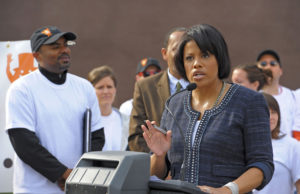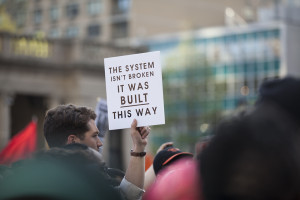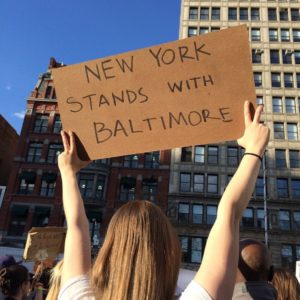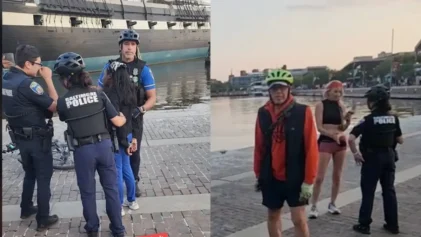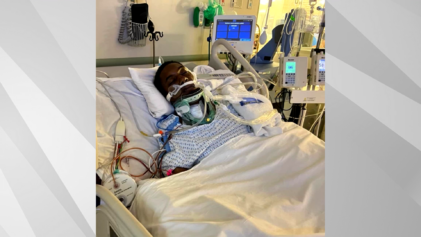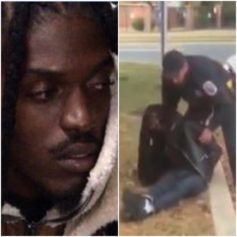
While it doesn’t confirm what exactly happened, it does help give a better idea of when Gray received the fatal injury. According to the report, there was no evidence that the 25-year-old was injured during the videotaped portion of his arrest, leaving what happened in the back of the transport van a mystery. It also noted that Gray had an injury to the back of his head that matched a bolt in the back of the van.
While this confirms the “catastrophic injury” happened while he was in police custody in the back of the van, it doesn’t confirm who authorities will deem responsible for snapping it.
The report also revealed that the transport vehicle made a mystery stop that had previously been unreported.
As this new information is released, it isn’t likely to help calm the frustrations of a community that has been watching hope dwindle away long before Gray’s death.
Windows. Cars. Store fronts. Street signs. Light posts. Baseball games.
These are only a few of the items that have now taken priority over Black lives in the aftermath of Gray’s death.
Somehow, as bullies with badges continue their violent attack on Black citizens, political powers continue ignoring the deplorable conditions many Black communities face and as America’s institutions continue to work the way they were always intended to (by white people and for white people), it’s actually the oppressed community that remains under harsh scrutiny.
It is the frustrated protesters who are the targets of condemnation and public shame after they destroyed the inanimate objects that filled the streets after authorities destroyed lives and families throughout the impoverished community.
The forgotten people who have been largely ignored until they started hurling rocks at the officers who have long sprayed them down with bullets are the ones that are getting a stern talking to delivered by the media, local school officials, authorities, local politicians and even the new attorney general.
All the while the Baltimore Police Department has pitched one excuse after another trying to explain away why they failed to follow protocol and abide by department regulations when arresting Gray.
Baltimore Mayor Stephanie Rawlings-Blake already faced heavy criticism from the public after she denounced protesters and rioters as “thugs” during an interview and ultimately shed light on the very reason many of the youth find it necessary to translate their frustrations in such a manner.
Members of the poverty-stricken community say they have begged for changes for years but it wasn’t until chaos swept the city that Rawlings-Blake finally decided to acknowledge their presence.
“A lot of us don’t like her,” said Jasmine Squirrel, a 25-year-old Baltimore resident that used to be one of Gray’s classmates in high school, according to the NY Times. “She don’t really do a lot for our city, the inner city, the schools and the youth. We don’t see her face in our community—the only time we did see her was around the time when it was time for her to get elected. The only reason why she’s out now is because they tore [the city] up.”
Even as she finally made her presence known in Baltimore’s low-income neighborhoods, she used her time there to add to an already extensive list of leaders condemning the community that is fighting to finally have change—not just in police reform, but in education, employment, economics, health and overall quality of life.
Regardless of how one feels about the morality of their tactics, the purpose behind it is clear, which makes descriptors like “senseless” inaccurate and offensive to a community already dwelling in centuries of pain.
Unfortunately, that’s exactly how new Attorney General Loretta Lynch described the protesters on Wednesday.
In her first public remarks on the unrest in Baltimore, Lynch condemned the city’s residents for what she called “senseless acts of violence” that worked against the purpose of improving relations with police.
It’s a statement that touts the same message that is promoted by Rep. Bobby Rush, who is a former Black Panther, Fox News pundits and the New York Post praising the “Hero mom” who beat her 16-year-old son after she spotted him tossing bricks at police—It’s your own fault that you don’t get along with the police.
The blame for police brutality and the oppression of the Black community is repeatedly being placed on the Black community, even by Black leaders, when one would think the universal message would be, “If you, police officers, want to get along with the communities you have been hired to serve and protect, stop killing them.”
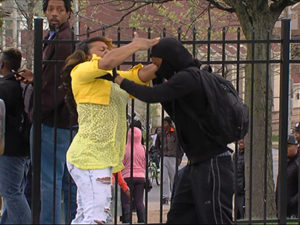
“The hypocrisy of white mainstream applauding Graham is sickening,” Salon’s Joan Walsh writes. “Let’s be honest: many white folks are reflexive critics of the greater frequency of corporal punishment in the black community. Witness the media horror at Minnesota Vikings running back Adrian Peterson beating his young son. If Graham beat her child like that in the aisles of CVS, you can be sure somebody would call CPS.”
But nobody called CPS. And they shouldn’t have. Graham was afraid for her son’s life. She knew, like many Black mothers do, that the police don’t need much of a reason to take a young Black man’s life.
The controversy comes in the way she was praised by mainstream media in a manner that suggested every Black mother needed to come get her “thug” son off the streets of Baltimore.
In Graham’s own words, all she wanted to do was ensure her son wouldn’t be another Freddie Gray. Let the irony settle here.
So as white mainstream media applauded her for snatching her son off the streets, they overlooked the fact that she did so in order to save her son from authorities—not the other way around.
Her actions were confirming the fear the Black community has to have of police. It was not about a mother who felt her son’s frustrations weren’t justified.
Even when the CEO of Baltimore City Public Schools, Gregory Thornton, released a statement on Tuesday promising to hold students accountable for vandalism and violence, he expressed an understanding of the deeply rooted issues that drove the students to that point.
He explained that when the youth of Baltimore look at the resources they have in their schools and compare it to more affluent communities, they can’t help but feel as if an entire system has left them behind.
“These are things kids have all across America, but when they look at their communities, it’s not afforded to them,” Thornton told the Sun. “Many of our kids feel that as a community we have not served them well.”
While he deemed the students’ actions “inexcusable,” it doesn’t seem like there are confirmed plans to suspend or expel students for their involvement in protests and riots.
Instead, the statement promises “principals and teachers are planning activities that will help students learn from the past days’ events” and revealed that “counselors, social workers, and psychologists will be on hand” for students.
Either way, the vast majority of all the disappointment and public outcry by people in positions of power has yet to be aimed at the Baltimore Police Department even as it has started backing away from accountability and transparency with the public.
Instead, the ploy to blame Gray for his own death continues.
Earlier this month, authorities insisted it was Gray’s own fault that officers didn’t secure his seatbelt in the back of the transport van because he was allegedly putting up too much of a fight while in handcuffs.
Now an account from the prisoner that was in the van with Gray could possibly be used as yet another excuse to let the officers off the hook.
Police documents obtained by the Washington Post revealed that the other man in the transport van, who was separated from Gray by a partition, said he heard Gray “banging against the walls” and believed he was “intentionally trying to injure himself.”
The Washington Post noted that the other man was not able to actually see Gray due to the partition between them.

Doctors told the Baltimore Sun that the fatal spine injuries would likely be caused by the type of “significant force” they might see in a car accident.
“You have to apply a significant amount of force in order to break somebody’s neck,” Dr. Ali Bydon, an associate professor of neurosurgery at the Johns Hopkins University School of Medicine said.
Another medical expert from the William Beaumont Health System in Michigan supported the claims and insisted that “it’s usually got to be a pretty forceful trauma” to sever a spine the way Gray’s had been.
To suggest Gray subjected himself to such trauma by banging himself against a partition seems to be a highly unlikely claim that other reporters are denouncing.
WBAL’s Jayne Miller told MSNBC that the Post’s story was “inconsistent with what we reported.”
“We have reported for some time that by the time that prisoner is loaded into that van, Freddie Gray was unresponsive. Secondly we have no medical evidence that Freddie Gray suffered any injury that would indicate that he had injured himself,” Miller told MSNBC’s Chris Hayes on Wednesday night.
Baltimore Police Commissioner Anthony W. Batts admitted that the officers did not secure Gray’s seatbelt or harness when they placed him in the transport van, nor did they acknowledge his repeated requests for medical attention.
But as officials, leaders and media headlines continue to avoid focusing on the real issues at hand, protesters across the nation are refusing to be deterred by claims that their frustration is “senseless” or unjust.
Protests have now spread to other cities across the U.S. including New York City and Ferguson, Missouri—a town all but too familiar with the realities of police brutality and racial disparities.
Small protests have also sparked in Boston, Houston, Washington D.C., Seattle and Denver.
